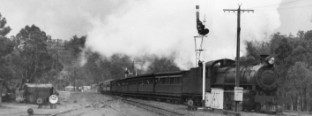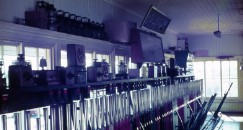It's east end abutted Claisebrook Road. It was elevated, no doubt so as to give the staff working the cabin a good view of the surrounding yard and junction. Such elevation was not only advantageous but necessary: East Perth was, even by that stage, a busy location, with a regular procession of suburban and goods trains on both the Eastern and the South West Railway shaking the box, as well as regular shunting trips to service the nest of nearby industrial sidings.
When it opened, East Perth No: 2 worked with Lord Street to the West,
Falkirk (now Maylands) to the East (both on the Eastern Railway), and
Burswood (later renamed Rivervale, now Burswood again!) on the South West Railway. Absolute block working (using
Sykes Instruments) applied on the Eastern Railway towards Lord Street, while Train Electric Staff working (large, until November 1913, when it was replaced by miniature) applied on the South West Railway to Burswood. Two-position Block using
Winters instruments was in use to
Falkirk. Falkirk's mantle as the next cabin along the Eastern Railway was lost in August 1905 when
Fenian's Crossing (now known as the Mt. Lawley Subway) was opened with two Temporary Block Cabins.
Fenian's Crossing Cabin 'A' was 500 yards west of the crossing and Fenian's Crossing Cabin 'B' was 300 yards East of the crossing in the cutting. Fenian's Crossing, the site of several accidents and fatalities since the line opened in 1881 was closed to allow for the construction of the railway bridges over The road to Guildford. In April 1907, these two temporary Cabins were closed and replaced by a new signal cabin at Mount Lawley.
On the South West Railway Belmont Park (which served the nearby racecourse) was opened in December 1915 as a "temporary" (read "intermittent") electric staff station. It was cut in from time to time to divide the Section to Burswood so as the facilitate more frequent movements over the single line between East Perth and Burswood during race days or special events or workings.
A loop was provided at East Perth for South West Trains, and this was almost certainly installed prior to the opening of the cabin. East Perth was a staff station from 1896, and while South West trains could have crossed there without such a facilty, through the simple expedient of holding the down train on the Eastern Railway to allow the Up to cross it ,such an arrangement would have created unacceptable delays.
The precise number of levers in cabin is not known, although given the cabin's dimensions the frame would have been limited to about 45 levers. The original signalling layout is uncertain, however, it probaly consisted of Up and Down homes for the Eastern and South West Railways, Up and Down distants and Up and Down starters for both lines, and Up and Down staters for the loop for the South West Railway. The Down distants were located on the post for the Down home for Lord Street.
East Perth was one of the few industrial areas in Perth during the early years of the Twentieth Century, and as the state slowly adjusted to the end of the gold rush boom years, both the number of industries located there, and the yard, slowly grew. In 1903 an Auxiliary (i.e. Outer ) Up Distant signal was installed on the Eastern Railway , probably as a concession to the fact that on the Eastern Railway the view of East Perth was partially obscured by a sweeping right-hand curve facing Up trains. In 1904 , yard improvements saw a number of changes and additions to the signaling and interlocking layout, involving the installation of a new crossover and new disc signals.
As befitting it's role as a major junction, East Perth had a number of safeworking idiosyncrasies. Around 1912, a Boucher's Patent Signal Flash Lamp was fitted to the down distant for the Eastern Railway, probably as a trial as there is no record of its use anywhere else. Presumably this trial proved unsatisfactory: in April 1913 it was replaced by ordinary lamp showing a steady light.
A much longer lasting feature of East Perth was its being the location of the only place where the tracks of the Perth Electric ( later WA Government ) Tramways crossed a railway line (in this case the siding into the Tramway workshop on the junction of Kensington Street and Claisebrook Road) on the level. A special set of catch points protected the Tramway's line, the points being operated by a lever locked by a special key which was kept under the care of the signalman when not in use. Trains shunting the siding could not be allowed to do so until "line clear' had been obtained from Lord Street, and had to be signalled using the block instruments, with the "Cancelled" signal being sent when the train had shunted clear of the main. As far as the author has been able to ascertain this working was unique to East Perth. The most probable reason for such an unusual arrangement was that the points for the Tramway siding were in the East Perth -Lord Street section, this hypothesis being supported by regular entries in the Annual reports listing the interlocking at the Tramway siding as being separate from East Perth.
This was not the only unusual working associated with East Perth : a special call attention signal (1-2) preceded "is line clear" signal to Lord Street for Up South West trains, while a special "be ready" signal had to be sent to Lord Street (so as to enable the gates across Lord Street to be closed for the shortest possible time)on the approach of an Up stopping train at East Perth. Whether or not this replaced the "Is line clear?" signal is not clear.
Less singular, but still unusual, was the local instruction (recorded in the 1909 General Appendix) providing that when Mount Lawley, Maylands and Bayswater were switched out Up trains could be accepted under the regulations applicable to "Section Clear but Station or Junction Blocked". Whether this local instruction was established to remind drivers, steaming at speed through a succession of clear signals, to approach East Perth cautiously so as to avoid the embarrassment of over running a home at danger (and possibly creating loud and expensive noises) is not now readily apparent.
East Perth number No. 2 was to be rendered obsolete by the need to relocate the WAGR's main locomotive depot from the badly congested Perth yard to a more spacious location. The decision to move the depot to East Perth was taken in 1912 and work on the new site commenced in 1914 . Progress was slow due to manpower and material shortages occasioned by the First world War and the depot ( forever to be colloquially known as East Perth Loco) did not open until after the Armistice. As a consequence of this work various temporary track and signaling arrangements were put in place, as well as permanent alterations introduced in early 1919 . In February that year the Up starters were moved to an impressive bracket, while the Eastern railway Up outer distant was relocated to the post of the Down home of the Summers Street cabin. Summers Street was a block post of which little information has survived. This February 1919 reference to the
Summers Street cabin is puzzling, as the cabin was not officially opened until 11 May 1919. It is possible that the cabin might have been operational for some time prior to this date, in which case Mount Lawley's mantle of being the next Down cabin to work with East Perth number 2 might have been briefly surrendered to Summers Street.
East Perth no 2 closed on 5 May 1919, following the opening of the third, and last, East Perth cabin. The new yard layout, with entrance to loco located between the Eastern Railway and the South Western Railway, required a larger signal cabin more centrally located than the existing arrangement. Due to it's being one of the most isolated railway systems in the world, the WAGR were great recyclers, and the cost saving opportunity presented by a redundant signal cabin was too good to pass. The cabin was relocated to Cottesloe- or more correctly, Jarrad Street, the main West to East thoroughfare of that suburb, which crossed the Railway a few chains south of Cottesloe station ) where it was to last until 1961. It also was closed to allow for the construction of a new signal cabin in conjunction with the opening of the Cottesloe to Leighton Independent freight line, a somewhat ironic end for a cabin that had spent the early part of its life controlling a junction. Perhaps even the WAGR had limits as to how far it was prepared to recycle.
Any additional information on this signal cabin would be most welcome - please use the e-mail form provided on this page.
Article researched and interpreted by Justin Smith © 2017
Hosted on SignallingWA by Chris. J. E. French
This page is copyright, and permission must be sought from SignallingWA and the Author / Copyright owner before this page is used for any purpose other than personal education.


